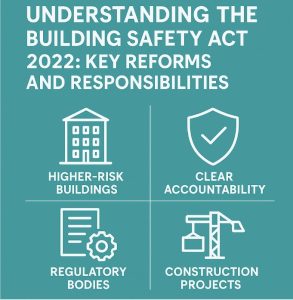The Building Safety Act: What It Means for Developers, Owners, and Buyers
Building Safety Act – an overview
The Building Safety Act 2022 was introduced to improve the standard of buildings, ensure that construction materials used in new buildings are fit for purpose, and to secure the safety of people living in buildings.
The Act was introduced following safety concerns expressed for occupants of high-rise buildings following the Grenfell Tower disaster in 2017. The aim of the legislation is to improve the design, construction and management of higher-risk buildings. The Act came into force on 1 April 2023.
What are the key areas of the Act?
 The Act represents significant reform to building safety regulations in England and Wales. The aim is to improve standards and accountability in the construction industry. There is also a strong focus on high-rise buildings. The Act also introduces significant legal and financial implications which include fines and imprisonment in the case of extreme breaches of the legislation.
The Act represents significant reform to building safety regulations in England and Wales. The aim is to improve standards and accountability in the construction industry. There is also a strong focus on high-rise buildings. The Act also introduces significant legal and financial implications which include fines and imprisonment in the case of extreme breaches of the legislation.
Here are some of the key areas covered:
New Regulatory Bodies: three new regulatory bodies have been established – the Buildings Safety Regulator, the National Regulator of Construction Products and the New Homes Ombudsman. These will oversee the safety and performance of buildings and address complaints about newly built homes.
Clear Accountability: those involved in the construction of buildings have clear responsibilities during the design, construction and completion stages of all buildings.
Building Owners’ Responsibilities: building owners are required to demonstrate that effective and proportionate measures are in place to manage building safety risks, especially in high-rise buildings.
Remediation orders: the Act introduces powers to compel the provision of information from ‘associated persons’, orders for landlords to contribute to the cost of any building safety remediation works, and orders requiring payment by a former landlord, developer, or other associated person (such as a group company).
New Protections for Leaseholders: importantly, all building owners and not just the leaseholders, are responsible for the cost of remediating historic building safety defects. This includes the removal or remediation of cladding which is found to be defective.
Residents’ Engagement: residents in high-rise buildings now have a greater say in the safety of their building. This means if you manage residential properties, you must take account of residents’ concerns and deal with them effectively.
Construction Products: this impacts on the construction supply chain to ensure the safety of construction products for their intended use. All manufacturers of these products must adhere to the new regulations.
Developer tax and levy: a new tax and levy has been introduced on developers. The purpose is to ensure developers contribute to the cost of rectifying building safety failures.
What should you be aware of if you are buying or selling a property?
If you are buying or selling property, there are certain aspects of the Act of which you should be aware.
Building Safety Certificate: Higher-risk buildings now require a Building Assessment Certificate issued by the Building Safety Regulator. As a buyer, ensure the seller provides this certificate to confirm the building complies with safety requirements.
Fire Safety and Cladding: If the property is in a building with cladding, check if remediation work has been completed or is planned. The Fire Safety (England) Regulations 2022, introduced alongside the Act, impose specific obligations on building owners or managers for fire risk assessments and evacuation plans.
Responsibility for Costs: The Act limits who can be charged for remediation of historical defects, focusing on developers and building owners. However, non-qualifying leaseholders may still bear costs. Buyers should ask for a breakdown of any service charges related to ongoing or completed safety works.
Building Management and Ongoing Compliance: Ask about the building’s Accountable Person, a role required under the Building Safety Act 2022 to manage safety risks. Check for ongoing maintenance obligations that could result in increased service charges.
Impact on Property Value and Marketability: Properties in non-compliant or unsafe buildings may have reduced marketability or mortgageability. Buyers should confirm whether lenders are willing to provide mortgages on the property and check for insurance coverage.
Social Media
The Buildings Safety Act was introduced to improve the standard of buildings and ensure that construction materials are fit for purpose – find out the essential points here.
Our latest article looks at the essence of the Buildings Safety Act and how to comply with this legislation.
For further information, please email:

